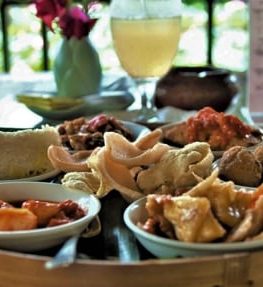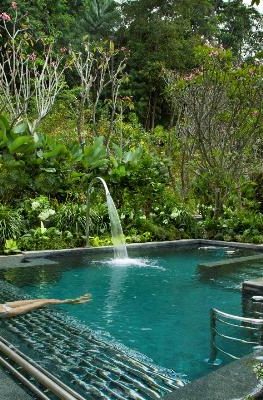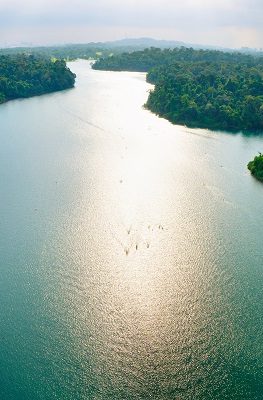Published on March 2, 2010
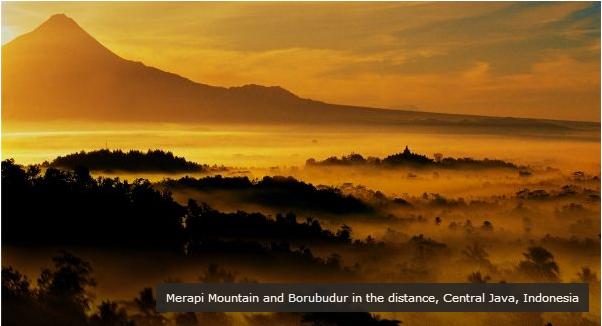
It didn’t take long for me to wish that I was back in Solo. The neighboring city of Yogyakarta—a mere 40 miles away—may attract tourists with its kraton (palace), taman sari (water castle) and cultural performances, but it isn’t exactly a restful place. Walking down a typical street means turning down half a dozen cycle rickshaw drivers asking inflated prices, and also rejecting a couple of offers of batik cloth. Arriving after dark in Yogyakarta and weighed down by a backpack, I also had the joy of dealing with hotel touts.
A few days earlier in Solo, on the other hand, I didn’t attract too much attention despite being very obviously an outsider. The city certainly has its share of hustle and bustle, yet it seemed to be much easier to get away from it all. And while Yogyakarta has its undoubted historical and cultural attractions, Solo has plenty of its own. It’s just a little quieter than the other.
Solo’s own kraton was founded in 1745 by Pakubuwono II of the Mataram Sultanate, who had sacked the old seat of power at Kartasura nearby. He is said to have chosen the new site under the influence of mysterious voices, but it did not prove to be particularly auspicious and the kingdom went into decline while the Yogyakarta court became more powerful. Solo would experience a revival in fortunes in the early 20th century, but after the Second World War it was again marginalized by its neighbor.
A large part of the kraton was destroyed by fire in 1985 and has been reconstructed, although the unusual octagonal tower did survive the flames. As I stood barefoot on the sand of the main courtyard and looked up at the tower, a group of gamelan players took their seats in the pendopo (an open pavilion with a hard floor).
About the most evocative sound of Indonesia that you could most likely find, the gamelan combines various instruments such as drums, gongs, and xylophones. I had already heard the complex, rapid clashing of the Balinese style, but here in the peaceful courtyard the slower and more harmonious Javanese gamelan seemed thoroughly appropriate.
Unfortunately, it is not possible to enter many of the palace buildings, as it is still inhabited even though the role of the susuhunan (king) is now largely ceremonial, but a jumbled museum shows off carriages, weapons, and other bits and pieces. An official palace guide is useful, because otherwise many of the objects will hold little meaning to visitors.
Arguably more interesting than the kraton is the Puri Mangkunegaran, a palace built in 1757 when the ruler’s nephew rebelled against his uncle and founded a rival dynasty. Although it is not as big as the kraton, many more rooms are accessible to the public and the guided tour was very informative.
I even had the opportunity to make a fool of myself by testing out a local legend that promises good luck if you can reach your arms around a particular pillar. I couldn’t quite make it until a Malaysian holidaymaker grabbed both my hands and forced them together, to the amusement of several passing Indonesians.
Next morning, I found myself on the back of a motorcycle heading out of Solo for the day. I was keen to explore the area around the city, and so at the recommendation of another visitor I had booked a tour at the Istana Griya guesthouse where I was staying. It turned out to be an excellent decision, as my guide Patrick was both knowledgeable and entertaining.
As we roared along, he shouted above the engine noise to tell me about the suburbs of Solo and later about the crops in the fields we passed. He was also happy to pause every now and then so that I could take photos. We stopped briefly in Patrick’s home village, which helped lend a personal tone to the tour.
It was a pleasure simply to ride through the Javanese countryside, but we did have a destination in mind—we would be visiting two of the many temples displaying Buddhist and Hindu characteristics on the slopes of the sacred Gunung Lawu. Mountains feature prominently in Javanese mythology and pilgrims still climb Gunung Lawu on auspicious days.
As we arrived at Candi Ceto, around 4,300 feet above sea level, mist was rolling in. It isn’t an easy site to reach by public transport, and the desolate atmosphere created by the weather was enhanced by the fact that we were the only ones there.
Built in the 15th century, towards the end of the rule of the Hindu Majapahit empire, the temple complex climbs the hillside over a series of terraces. Patrick pointed out the various fertility symbols around the place, some of them reasonably subtle and others much less so—a large lingam (phallic sculpture) had been given its own little shelter.
After lunch we visited the second temple, Candi Sukuh, which dates from the same era as Candi Ceto, It also has quite a few fertility symbols and erotic carvings around the place, and Patrick was able to tell me what is known about them, but the most fascinating thing about the site is the shape of the temple building itself. In the form of a pyramid with a flat top, it looks remarkably like one of the famous Inca temples of South America and not at all like any other Indonesian temples of the period. I followed Patrick up the narrow steps on the front of the structure, discovering that the temple is still a focal point for pilgrims: incense sticks had been burned in a pot, and petals had been left as an offering. Before leaving we stopped to take stock of the view of the site and of the rice fields beyond. Although Candi Sukuh is easier to reach than Candi Ceto, we were still the only ones there.
Back in Solo for the evening, I followed another tip from one of the guesthouse residents—it’s that kind of place—and took my seat at one of the city’s regular cultural shows. It was a bit of a mixed bag, some traditional music and dancing accompanied by interminable comedy routines in Javanese and a fashion show. The impression I was left with was that the event was aimed at Indonesians, not staged specifically for tourists. But in many ways, that summed up what I liked about Solo.
Go
Express trains (infoka.kereta-api.com) run from Jakarta, taking from seven to 10 hours and costing from Rp110,000 (Php530) to Rp270,000 (Php1,300). Cheaper but less comfortable non-express trains are also available.
Explore
Motorcycles can be rented at many hotels and guesthouses. Expect to pay around Rp 60,000 (Php 290) per day.
Dine
• The city boasts some of Java’s best street food. Popular dishes include nasi liwet – rice cooked in coconut milk and served with green papaya and chicken. Try the stalls on Jelan Keprabon or ask for advice at your hotel.
• Warung Baru on Jalan Ahmad Dahlan is a popular backpacker place close to the Istana Griya guesthouse, with a large menu and a range of tours on offer.
• Mama Titin’s Sunda Kitchen (Jalan Rajiman) is popular with ex-pats for its authentic Sundanese (West Javanese) food.
Stay
• Istana Griya (tel. +62 632 667; http://www.istanagriya.tripod.com) is a peaceful and friendly guesthouse with a pleasant area to sit and meet other travelers.
• Diamond (tel. +62 733 888) on Jalan Slamet Riyadi is a popular mid-range option. Ask whether discounts are available.
Get
Solo is one of the centers of production for batik, fabric on which a pattern is drawn in wax so that when it is dyed the pattern retains the original color. The Pasar Klewer on Jalan Secoyadan is the largest batik market in Indonesia and is aimed more at locals than tourists, selling mostly batik cap (which uses pre-made stamps) rather than batik tulis (drawn by hand). Remember to bargain.
Borobudur
One of the most remarkable sites in Southeast Asia, the immense temple at Borobudur was built around 1,200 years ago. The decline in Buddhism in the region meant that it was forgotten and eventually covered by volcanic ash, but it was rediscovered in 1815 and restoration has continued sporadically ever since. Built around a hill, the temple’s carvings illustrate a Buddhist view of the cosmos, with worldly desires at the base and nirvana at the top; official guides can explain some of the symbolism.
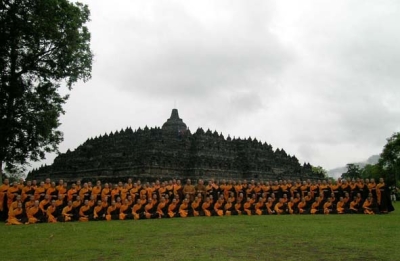
Although most people use Yogyakarta as a base for visiting the temple, if you have your own transport you can stop at Borobudur on the journey between Solo and Yogyakarta.
This article was provided by Philippine Airlines’ Mabuhay Magazine.Mabuhay Magazine is published by Eastgate Publishing Corporation (email: info@eastgatepublishing.com; website: www.eastgatepublishing.com).




